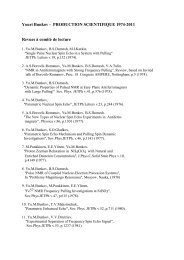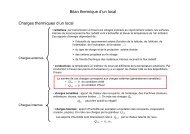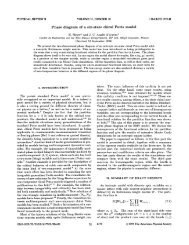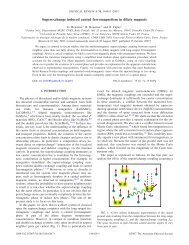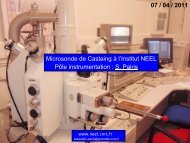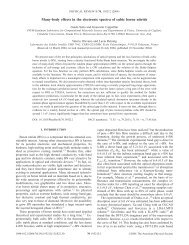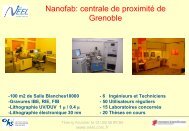Activity Report 2010 - CNRS
Activity Report 2010 - CNRS
Activity Report 2010 - CNRS
Create successful ePaper yourself
Turn your PDF publications into a flip-book with our unique Google optimized e-Paper software.
SCIENTIFIC REPORT<br />
FURTHER READING:<br />
[3] Phys. Rev. B 81, 134408 (<strong>2010</strong>)<br />
Effect of crystalline defects on domain wall<br />
motion under field and current in<br />
nanowires with perpendicular<br />
magnetization<br />
[4] New J. Phys. 12, 103040 (<strong>2010</strong>)<br />
Ultrathin epitaxial cobalt films on graphene<br />
for spintronic investigations and applications<br />
[5] Appl. Phys. Lett. 96, 262509 (<strong>2010</strong>)<br />
Effect of structural relaxation and oxidation<br />
conditions on interlayer exchange coupling<br />
in Fe|MgO|Fe tunnel junctions<br />
[6] Phys. Rev. B 81, 220407 (<strong>2010</strong>)<br />
Oscillatory interlayer exchange coupling in<br />
MgO tunnel junctions with perpendicular<br />
magnetic anisotropy<br />
[7] Science 315 349 (2007)<br />
Electric Field-Induced Modification of<br />
Magnetism in Thin-Film Ferromagnets<br />
8<br />
the depinning of the domain wall from a<br />
single pinning centre using spin polarized<br />
current injection [3]. Combining<br />
structural and magnetic contrast in<br />
Lorentz imaging it was possible to show a<br />
clear correlation between a micromacle<br />
and the domain wall pinning in a FePt<br />
nanowire.<br />
Please read the corresponding Highlight<br />
at the end of this report for further<br />
information<br />
Perpendicular Anisotropy<br />
and exchange interactions<br />
Chair of Excellence 2007: Mairbek<br />
CHSHIEV<br />
PhD student: Hongxin YANG<br />
(INAC/SPINTEC).<br />
Perpendicular anisotropy materials play a<br />
more and more important role for the<br />
design of spintronics devices. Here,<br />
theoretical electronic band structure<br />
calculations provide an important mean<br />
to study the effect and the role of the<br />
structural properties on the electronic<br />
and magnetic properties and thus a guide<br />
for the development of spintronics<br />
devices. Confirming recent experiments<br />
relevant to strong perpendicular<br />
magnetic anisotropy (PMA), it is shown<br />
by first principles calculation that the PMA<br />
in Fe/MgO magnetic tunnel junctions<br />
(MTJ) can be as large as 3 erg/cm 2 . The<br />
nature of the PMA has been clarified and<br />
is attributed to the hybridization between<br />
Fe and oxygen orbitals via spin orbit<br />
interaction (SOI). Additional oxygen or<br />
oxygen vacancies at the interface,<br />
destroys the hybridization between Fe<br />
and oxygen and leads to a reduction of<br />
the PMA. Hence good crystalline quality<br />
of the Fe/MgO interface is of importance<br />
to obtain a large PMA.<br />
Similarly, in order to explain recent<br />
experiments realized at Institut Néel, it<br />
has been confirmed by calculation that a<br />
strong PMA is induced at Co/graphene<br />
interfaces [4].<br />
As a further result of the band structure<br />
calculations it has been revealed that<br />
structural relaxation influences the<br />
interlayer exchange coupling (IEC)<br />
between the Fe layers in Fe/MgO/Fe<br />
tunnel barriers. In particular oxygen<br />
vacancies increase the antiferromagnetic<br />
coupling strength, while oxygen rich<br />
interfaces decrease the coupling or<br />
induce a ferromagnetic interaction [5].<br />
Finally, oscillations of the IEC as a<br />
function of the ferromagnetic layer<br />
thickness in magnetic tunnel junctions of<br />
PMA ferromagnetic layers has been<br />
observed experimentally and explained in<br />
the frame of a free electron model [6].<br />
An experimental study (“fil de l’eau” PhD<br />
student 2007: Marcio MEIDEROS-<br />
SOARES) of the exchange coupling<br />
between antiferromagnetic PtMn and<br />
chemically ordered ferromagnetic FePt<br />
with strong PMA has been performed to<br />
better understand the exchange bias<br />
mechanism. XMCD measurements<br />
(ID08/ESRF beamline) at the Mn and Fe<br />
L 2 , L 3 -edges show that the major part of<br />
the Mn spins reverse along with the Fe<br />
spins and thus only 10% contribute to<br />
the exchange-bias shift. This outcome<br />
shows that interfacial Mn spins are<br />
strongly coupled to the ferromagnetic<br />
FePt layer and less coupled to the spins<br />
inside the antiferromagnetic layer.<br />
Electric field control of<br />
anisotropy<br />
RTRA Project 2007: POMME<br />
Coordinator: Dominique GIVORD (Institut<br />
Néel).<br />
As a new approach to control the intrinsic<br />
magnetic properties in metals, a large<br />
electric field is used to appreciably<br />
change the electron density at surfaces<br />
or interfaces in ultrathin ferromagnetic<br />
metal films. This has been demonstrated<br />
in 2007 by the Institut Néel for FePt and<br />
FePd immersed in an electrolyte where<br />
the magneto-crystalline anisotropy can<br />
be reversibly modified by an applied<br />
electric field [7]. The aim of the current<br />
studies is to replace the electrolyte with<br />
an insulating material to charge the<br />
ferromagnetic surface (Fig. 2). The<br />
challenge is to develop oxide overlayers<br />
of high breakdown voltage.<br />
Fig. 2: FEM simulation of the electric field and<br />
surface charge induced on a nanocontact. The<br />
charge distribution is maximum at the apex of<br />
the nanocontact<br />
Al 2 0 3 and HfO 2 barriers have been<br />
prepared by Atomic Layer Deposition<br />
(ALD) that permits to grow extremely<br />
homogeneous and compact layers. The<br />
mean voltage breakdown shows that the<br />
goal of 10 8 V/m has been reached<br />
allowing the application of strong electric<br />
fields to the surface. The next step will be<br />
to characterize the effect on a 2 nm FePt<br />
thin film under electric fields of more



